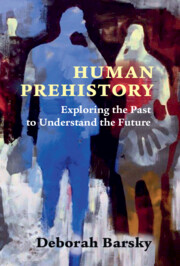26 results
Notes
-
- Book:
- Human Prehistory
- Published online:
- 20 August 2022
- Print publication:
- 18 August 2022, pp 207-219
-
- Chapter
- Export citation
5 - The Ascent of Paleolithic Cultures
-
- Book:
- Human Prehistory
- Published online:
- 20 August 2022
- Print publication:
- 18 August 2022, pp 84-100
-
- Chapter
- Export citation
Copyright page
-
- Book:
- Human Prehistory
- Published online:
- 20 August 2022
- Print publication:
- 18 August 2022, pp iv-iv
-
- Chapter
- Export citation
3 - Becoming Human
-
- Book:
- Human Prehistory
- Published online:
- 20 August 2022
- Print publication:
- 18 August 2022, pp 47-60
-
- Chapter
- Export citation
1 - A Brief Introduction to Prehistoric Archeology
-
- Book:
- Human Prehistory
- Published online:
- 20 August 2022
- Print publication:
- 18 August 2022, pp 5-25
-
- Chapter
- Export citation
10 - Technology and Human Alienation from Nature
-
- Book:
- Human Prehistory
- Published online:
- 20 August 2022
- Print publication:
- 18 August 2022, pp 163-172
-
- Chapter
- Export citation
Introduction
-
- Book:
- Human Prehistory
- Published online:
- 20 August 2022
- Print publication:
- 18 August 2022, pp 1-4
-
- Chapter
- Export citation

Human Prehistory
- Exploring the Past to Understand the Future
-
- Published online:
- 20 August 2022
- Print publication:
- 18 August 2022
-
- Textbook
- Export citation
8 - Communication Networking at the End of the Prehistoric Era
-
- Book:
- Human Prehistory
- Published online:
- 20 August 2022
- Print publication:
- 18 August 2022, pp 134-145
-
- Chapter
- Export citation
13 - The Role of Prehistory in Understanding the Modern Human Condition
-
- Book:
- Human Prehistory
- Published online:
- 20 August 2022
- Print publication:
- 18 August 2022, pp 198-206
-
- Chapter
- Export citation
9 - Global Warming
-
- Book:
- Human Prehistory
- Published online:
- 20 August 2022
- Print publication:
- 18 August 2022, pp 146-162
-
- Chapter
- Export citation
Figures
-
- Book:
- Human Prehistory
- Published online:
- 20 August 2022
- Print publication:
- 18 August 2022, pp x-xi
-
- Chapter
- Export citation
12 - On Religion, War and Terrorism in the Globalized World
-
- Book:
- Human Prehistory
- Published online:
- 20 August 2022
- Print publication:
- 18 August 2022, pp 184-197
-
- Chapter
- Export citation
Dedication
-
- Book:
- Human Prehistory
- Published online:
- 20 August 2022
- Print publication:
- 18 August 2022, pp v-vi
-
- Chapter
- Export citation
Index
-
- Book:
- Human Prehistory
- Published online:
- 20 August 2022
- Print publication:
- 18 August 2022, pp 239-244
-
- Chapter
- Export citation
Contents
-
- Book:
- Human Prehistory
- Published online:
- 20 August 2022
- Print publication:
- 18 August 2022, pp vii-ix
-
- Chapter
- Export citation
2 - Prehistory
-
- Book:
- Human Prehistory
- Published online:
- 20 August 2022
- Print publication:
- 18 August 2022, pp 26-46
-
- Chapter
- Export citation
A Word about the Book Cover
-
- Book:
- Human Prehistory
- Published online:
- 20 August 2022
- Print publication:
- 18 August 2022, pp xiv-xiv
-
- Chapter
- Export citation
References
-
- Book:
- Human Prehistory
- Published online:
- 20 August 2022
- Print publication:
- 18 August 2022, pp 220-238
-
- Chapter
- Export citation
Acknowledgments
-
- Book:
- Human Prehistory
- Published online:
- 20 August 2022
- Print publication:
- 18 August 2022, pp xiii-xiii
-
- Chapter
- Export citation



